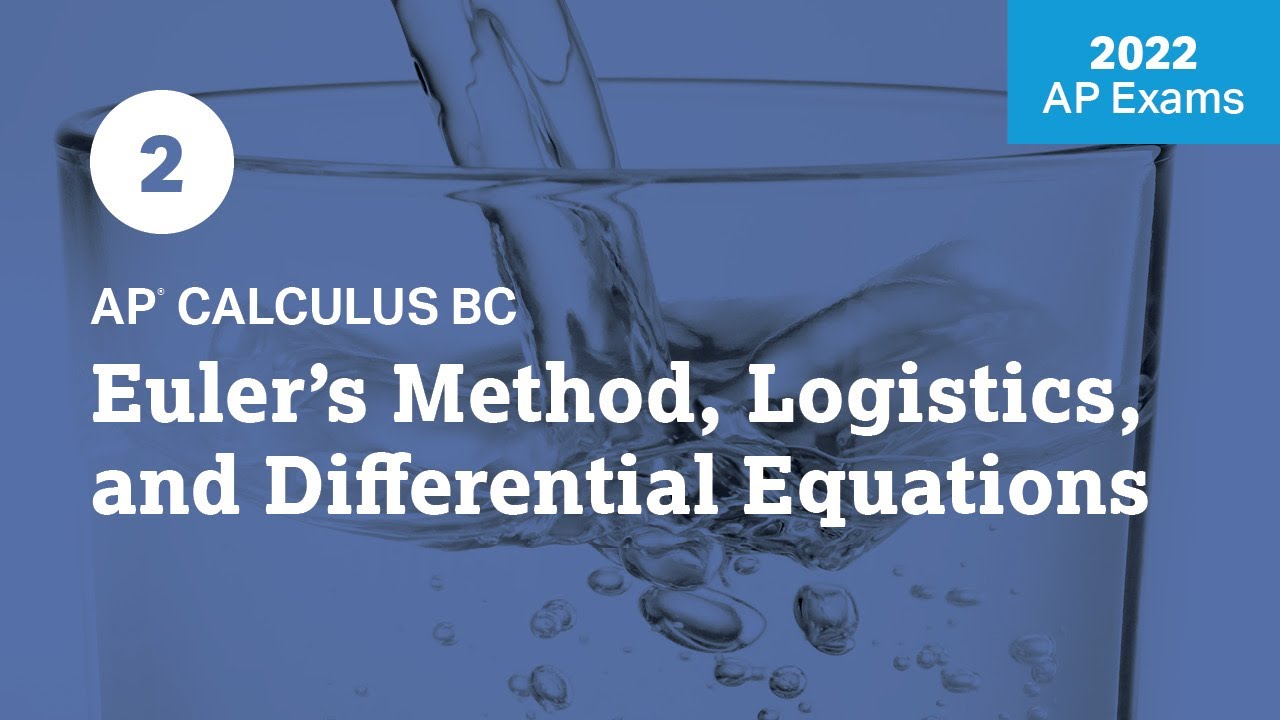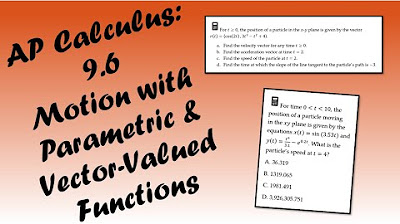2022 Live Review 6 | AP Calculus BC | Working with Parametric Equations and Vectors
TLDRIn this engaging calculus review session, Brian Passwater and Tony Record delve into parametric equations and vector-valued functions, key topics for AP Calculus BC students. They cover the connection between particle motion from earlier courses and the current material, emphasizing the minimal use of vectors in the AP exam. The session includes solving for acceleration, using derivatives to find the slope of a tangent line, and understanding the total distance traveled by a particle. The educators also discuss the importance of familiarizing oneself with formulas and using a graphing calculator effectively. The video serves as a comprehensive guide for students aiming to solidify their understanding of these concepts in preparation for the AP exam.
Takeaways
- 📚 The session focuses on reviewing parametric equations and vector value functions for Calculus BC students.
- 👨🏫 The instructors are Brian Passwater and Tony Record, both high school teachers with expertise in calculus.
- 📈 The session covers the relationship between parametrics and vectors, emphasizing their significance in Unit 9 of the course and exam description.
- 🔍 The use of vectors in the AP exam is minimal, focusing on understanding vector form as separate equations for x and y coordinates.
- 📊 The session includes practice problems involving derivatives and acceleration in parametric motion, with solutions provided.
- 🎓 The instructors emphasize the importance of understanding where to find information and how to apply it, especially for exam preparation.
- 📱 The use of graphing calculators is integral to solving certain problems, and students should be familiar with their calculator's functions.
- 🤔 The session highlights the importance of recognizing the common mistakes in parametric problems and the need for careful problem-solving.
- 📝 Students are encouraged to review and practice problems multiple times to reinforce understanding and confidence.
- 🎯 The session aims to connect concepts from different units of the calculus course, ensuring a comprehensive understanding for the AP exam.
- 📌 The session provides resources and guidance on how to use the College Board's YouTube channel and other materials for further study.
Q & A
What is the main topic of discussion in the video?
-The main topic of discussion in the video is parametric equations and vector value functions in the context of Calculus BC for students preparing for the AP exam.
Who are the presenters in the video and where do they teach?
-The presenters in the video are Brian Passwater, who teaches at Speedway High School in Speedway, Indiana, and Tony Record, a teacher at Avon High School just west of Indianapolis.
What is the significance of the position equation in finding acceleration?
-The position equation is significant because by differentiating it twice, you can find the velocity (first derivative) and acceleration (second derivative) of a particle in motion.
How is the concept of vectors related to parametric equations?
-The concept of vectors is related to parametric equations in that vectors can be used to represent the motion of a particle in two dimensions, with each component of the vector corresponding to the position function in the x and y directions.
What is the purpose of the 'scan me' documents and where can they be accessed?
-The 'scan me' documents provide supplementary material for reviewing parametrics and vectors. They can be accessed through the website or by scanning the QR code provided in the video.
What is the significance of the slope of a tangent line in the context of the video?
-The slope of a tangent line is significant because it represents the rate of change of the function at a specific point. In the video, it is used to find the slope of the tangent line to the path of a moving particle at a given time.
How do the presenters handle the use of a graphing calculator in solving problems?
-The presenters emphasize the importance of knowing how to use a graphing calculator effectively, including how to communicate the steps taken on the calculator during the exam. They also mention that while the calculator can perform the calculations, the student must understand how to interpret and use the results correctly.
What is the relevance of the fundamental theorem of calculus in this context?
-The fundamental theorem of calculus is used to find the position of a particle at a given time by integrating the velocity function from an initial time to the time in question.
How does the video address the concept of limits in Calculus BC?
-The video addresses the concept of limits by discussing how to find the limit of a function as time approaches infinity, which is relevant when determining the long-term behavior of a function, such as the y-coordinate of a particle's position that will never exceed a certain value.
What advice do the presenters give for students preparing for the AP Calculus BC exam?
-The presenters advise students to familiarize themselves with the formulas, get comfortable with using a graphing calculator, and make connections with the concepts learned in previous courses. They also encourage students to practice problems and not to give up as there is still time to prepare for the exam.
Outlines
📚 Introduction to Parametric Equations and Vector Value Functions
The video begins with the hosts, Tony and Brian, discussing the relevance of parametric equations and vector value functions for calculus BC students. They introduce themselves and their teaching backgrounds, with Tony from Speedway High School and Brian from Avon High School. They encourage viewers to access the College Board's YouTube channel for additional review sessions and emphasize the importance of understanding these concepts for the AP exam. The hosts also highlight the close relationship between parametrics and vectors, noting their significance in Unit 9 of the course and exam description.
🔍 Differentiating Position Equations
In this segment, the hosts delve into the process of differentiating position equations to find velocity and acceleration. They explain the concept of particle motion and how it applies to both single-variable calculus (AB) and multi-variable calculus (BC). The hosts work through an example problem, demonstrating how to find the acceleration from a given position equation. They also discuss the importance of understanding the context of the problem, such as the time at which the acceleration is being calculated.
📱 Graphing Calculator Usage in AP Exam
The hosts discuss the use of graphing calculators in the AP exam, particularly for the multiple-choice section. They explain that while not all problems require a calculator, it's crucial to know how to use it effectively and to communicate the process clearly on the exam. They provide tips on how to use the calculator for parametric equations and emphasize the importance of showing work for partial credit. The hosts also mention that the AP exam allows for calculator use to find the slope of a tangent line, a concept that remains consistent across different systems of calculus.
🕒 Finding the Slope of a Tangent Line
This paragraph focuses on the concept of finding the slope of a tangent line at a specific time. The hosts explain that the slope of a tangent line is a constant value and demonstrate how to calculate it using given derivatives of x and y with respect to time. They show how to use the chain rule and quotient rule to differentiate the given functions and find the slope at time t equals two. The hosts also discuss the importance of using the correct formula and calculator functions to arrive at the correct answer.
🐞 Motion Analysis of a Bug in the XY Plane
The hosts present a problem involving a bug moving in the XY plane, with given position functions for x and y. They explain how to determine when the bug is at rest by setting the velocity in both the x and y directions to zero. The hosts work through the problem step by step, using algebraic techniques to find the time when the bug is at rest and discussing the significance of the unit circle in relation to the cosine function. They also emphasize the importance of understanding the direction of motion in parametrics.
📈 Calculating Speed and Direction of Motion
In this section, the hosts focus on calculating the speed and direction of a particle's motion in the XY plane. They discuss the concept of speed as the square root of the sum of the squares of the derivatives of x and y with respect to time. The hosts work through a problem that involves finding the speed of a particle at a given time and discuss how to use the graph of y(t) and the given tangent line to determine the slope and thus the direction of motion. They emphasize the importance of understanding the relationship between derivatives and the motion of a particle.
🧮 Second Derivatives in Parametric Equations
The hosts tackle the concept of second derivatives in parametric equations, explaining the procedure and providing a step-by-step example. They discuss the common mistakes students make when finding second derivatives and how to avoid them. The hosts also mention the importance of understanding the relationship between derivatives and the motion of a particle, and how this understanding can help solve complex problems involving parametrics.
📊 Total Distance Traveled by a Particle
This paragraph discusses the concept of finding the total distance traveled by a particle in the XY plane. The hosts explain the formula for calculating total distance in parametrics and demonstrate how to use a graphing calculator to find the integral. They provide a detailed example, showing how to set up the problem, use the calculator to find the integral, and interpret the result. The hosts also emphasize the importance of understanding the context of the problem and the significance of the total distance traveled.
🌟 Approaching Limits in Parametric Motion
The hosts explore the concept of limits in parametric motion, focusing on how to find the position a particle approaches as time increases without bound. They discuss the use of the fundamental theorem of calculus and the importance of identifying the most dominant terms in the numerator and denominator when evaluating limits. The hosts work through a problem that involves finding the x and y coordinates of the particle's position as t approaches infinity, providing a detailed explanation of the process and the significance of the results.
Mindmap
Keywords
💡Calculus BC
💡Parametric Equations
💡Vector-Valued Functions
💡Velocity
💡Acceleration
💡Graphing Calculator
💡Tangent Line
💡Integration
💡Limits
💡Fundamental Theorem of Calculus
Highlights
The session focuses on parametric equations and vector value functions, crucial topics for Calculus BC students.
Presenters Brian Passwater and Tony Record are both teachers, providing insights from their experience in teaching Calculus.
Parametric equations and vectors are closely tied, often considered as the same kind of concepts in Calculus BC.
The session provides a comprehensive review of key concepts, including particle motion and velocity in multiple directions.
The use of vectors in the AP exam is minimal, focusing on recognizing vector forms and their applications in parametric equations.
The session emphasizes the importance of understanding the differentiation process for position, velocity, and acceleration in parametric equations.
The presenters discuss the significance of the slope of a tangent line in the context of parametric equations and how it remains constant in the x-y plane.
The session provides practical advice on using graphing calculators effectively for the AP exam, including how to communicate calculator work clearly.
The concept of 'at rest' in parametrics is explained, where both x and y directions must have zero velocity simultaneously.
The session addresses common mistakes and provides strategies to avoid them, such as the importance of accurate calculations and understanding the problem fully before solving.
The session concludes with a review of the fundamental theorem of calculus and its application in finding the position of a particle in parametrics.
The importance of practice and review is emphasized, with encouragement for students to engage with additional resources like videos and flashcards.
The session highlights the connection between concepts learned in Calculus AB and BC, reassuring students that the foundational knowledge is transferable.
The session ends with a reminder of the resources available for students to download and prepare for the upcoming review sessions.
Transcripts
Browse More Related Video

1 | MCQ | Practice Sessions | AP Calculus BC

2021 Live Review 3 | AP Calculus BC | Everything You Need to Know About Parametrics

2022 Live Review 2 | AP Calculus BC | Euler's Method, Logistics, and Differential Equations

AP Calculus BC Lesson 9.6

3 | FRQ (No Calculator) | Practice Sessions | AP Calculus BC

2 | FRQ (Calculator Active) | Practice Sessions | AP Calculus BC
5.0 / 5 (0 votes)
Thanks for rating: